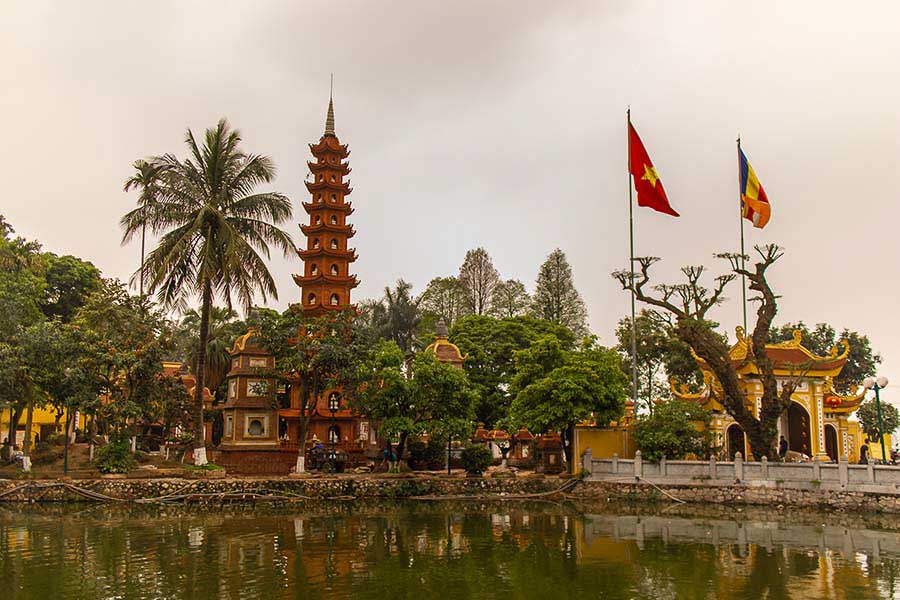Pagodas are a common sight in Vietnam, with thousands of these religious structures scattered throughout the country’s villages, towns, and cities. These pagodas have played an important role in Vietnam’s social, cultural, and religious history, and continue to be significant to this day. This article will explore the history, architecture, and significance of pagodas in Vietnam while highlighting some of the most famous examples in different regions of the country.

History of Pagodas in Vietnam
The history of pagodas in Vietnam dates back over 2,000 years to the time of the legendary Hung Kings. During this time, pagodas were used as places of worship for local gods and spirits. Buddhism arrived in Vietnam in the 1st century AD and became the dominant religion by the 11th century, leading to the construction of many Buddhist pagodas throughout the country.
Over the centuries, pagodas have been built, destroyed, and rebuilt numerous times due to wars, natural disasters, and political changes. Despite this, they have remained an integral part of Vietnamese culture. Today, Vietnam is home to some of the world’s most stunning and unique pagodas, each with its own story to tell.

Architecture of Pagodas in Vietnam
Vietnamese pagodas are renowned for their unique architectural features and elaborate designs. They typically consist of a number of halls or rooms arranged around a central courtyard, with a main hall (known as the Buddha hall) containing statues of the Buddha and other important figures.
One of the most distinctive features of Vietnamese pagodas is the multi-tiered roof, which is often adorned with intricate carvings, vibrant colors, and symbolic images. The architecture of pagodas in Vietnam is also heavily influenced by Chinese and Indian styles, resulting in a unique blend of different cultural traditions.

Influential Pagodas in Vietnam
Over the centuries, many pagodas in Vietnam have played important roles in shaping the country’s cultural, religious, and political landscape. From the ancient pagodas of the Hung Kings to the modern-day landmarks of Ho Chi Minh City, each of these structures has its own story to tell.
Some of the most influential pagodas in Vietnam include the One Pillar Pagoda in Hanoi, which is said to represent a lotus flower growing out of the water; the Perfume Pagoda near Hanoi, which attracts thousands of pilgrims each year during the spring festival; and the Thien Mu Pagoda in Hue, which was used as a base by Buddhist monks during the Vietnam War.
Religious Significance of Pagodas in Vietnam
For many Vietnamese people, pagodas are places of worship and spiritual refuge. They are seen as sacred spaces where individuals can connect with the divine, seek guidance from ancestors, and find inner peace.
Buddhism is the primary religion associated with pagodas in Vietnam, although other belief systems such as Taoism and Confucianism also play a significant role. Many pagodas offer regular services and ceremonies, such as chanting sessions and meditation classes, to help people deepen their spiritual practice.
Cultural Significance of Pagodas in Vietnam
In addition to their religious significance, pagodas also play an important role in Vietnamese culture. They are often used as venues for cultural events, such as music and dance performances, festivals, and art exhibitions.
Many pagodas are also home to valuable artifacts and works of art, including ancient statues, paintings, and calligraphy. These treasures provide insight into Vietnam’s rich cultural heritage and are prized by scholars and enthusiasts around the world.
Famous Pagodas in Northern Vietnam
Northern Vietnam is home to some of the country’s most famous and historically significant pagodas. These include:
- One Pillar Pagoda: Located in Hanoi, this pagoda was built in the 11th century and is one of Vietnam’s most iconic structures. Legend has it that the pagoda was constructed after Emperor Ly Thai Tong had a dream in which he was given a son by the bodhisattva Avalokiteshvara, who was sitting on a lotus flower.

- Tran Quoc Pagoda: Situated on an island in Hanoi’s West Lake, Trac Quoc Pagoda is one of the oldest Buddhist temples in Vietnam, dating back to the 6th century. The pagoda features a tall tower and several pavilions, as well as a beautiful garden and courtyard.

- Perfume Pagoda: Located about 60 kilometers southwest of Hanoi, the Perfume Pagoda is a complex of temples and shrines built into the limestone cliffs of Huong Tich Mountain. Visitors must take a scenic boat ride followed by a hike up a steep mountain path to reach the main temple, which is believed to house a fragment of Gautama Buddha’s robe.

- Bai Dinh Pagoda: Located in Ninh Binh Province, about 95km south of Hanoi, Bai Dinh Pagoda is known as the largest Buddhist complex in Southeast Asia. Its impressive scale and grandeur make it a must-see destination for many tourists. The pagoda boasts several ornate temples, towering statues, and beautiful gardens spread across an area of over 500 hectares.

- Yen Tu Pagoda: Situated on Yen Tu Mountain, Quang Ninh Province, Yen Tu Pagoda is considered as the cradle of Vietnamese Buddhism. It houses a series of pagodas and temples built on the slopes of the mountain, where visitors can hike through scenic trails surrounded by lush forests and enjoy panoramic views of the coastline. The most popular attraction is Dong Pagoda, situated at the peak of Yen Tu Mountain, which offers stunning vistas and spiritual experiences.

- But Thap Pagoda: Located in Bac Ninh Province, about 20km northeast of Hanoi, But Thap Pagoda is renowned for its exquisite architecture and cultural significance. Built-in the 13th century, it features a unique blend of Vietnamese and Chinese styles, with intricate carvings and sculptures adorning its walls and roofs. Visitors can admire ancient artifacts and relics inside the pagoda’s many halls and explore the peaceful gardens surrounding the complex.

Famous Pagodas in Central Vietnam
Central Vietnam is home to many pagodas that showcase the region’s rich cultural heritage and natural beauty. Some of the most famous examples include:
- Thien Mu Pagoda: Located on the banks of the Perfume River in Hue, Thien Mu Pagoda is one of the most important religious sites in Vietnam. The pagoda features a seven-story tower that offers panoramic views of the surrounding countryside, as well as several other shrines and temples.

- Linh Ung Pagoda: Situated on the slopes of Son Tra Mountain near Danang, Linh Ung Pagoda is a modern temple complex that was built in the 21st century. The pagoda features a giant statue of the bodhisattva Avalokiteshvara, as well as several other impressive structures and gardens.

- Huyen Khong Son Thuong Pagoda: Nestled amidst the majestic Marble Mountains in Da Nang city, Huyen Khong Son Thuong Pagoda is a hidden gem that offers breathtaking views of the surrounding landscape. The pagoda is renowned for its intricate carvings, murals, and statues that depict Buddhist legends and teachings. Visitors can also explore the nearby caves and grottos, which are believed to have served as sanctuaries for monks and hermits in ancient times.

Famous Pagodas in Southern Vietnam
Southern Vietnam is home to many pagodas that reflect the region’s unique blend of different cultural influences. Some of the most famous examples include:
- Vinh Nghiem Pagoda: Located in Ho Chi Minh City, Vinh Nghiem Pagoda is one of the largest Buddhist temples in Vietnam. The pagoda features a strikingly modern design with a unique combination of Vietnamese and Western architectural elements.

- Ba Den Pagoda: Situated on the summit of Ba Den Mountain in Tay Ninh Province, Ba Den Pagoda is a popular pilgrimage site for Vietnamese Buddhists. The pagoda features several shrines and temples, as well as a cable car that offers breathtaking views of the surrounding countryside.

- Ha Tien Pagoda: Located in the town of Ha Tien near the Cambodian border, Ha Tien Pagoda is a small but picturesque temple that dates back to the 18th century. The pagoda features several ornate structures and is known for its beautiful garden and pond.

Tourism and Pagodas in Vietnam
Pagodas play an important role in Vietnam’s tourism industry, attracting millions of visitors each year from around the world. Many pagodas offer guided tours, cultural performances, and other activities that allow visitors to learn more about Vietnamese culture and history.
The popularity of pagodas has also led to concerns about overcrowding and damage to these historic sites. To address these issues, many pagodas have implemented measures to limit tourist numbers and protect their architectural and cultural heritage.

Conclusion
Vietnamese pagodas are not just religious structures; they are also significant cultural and historical landmarks that embody the country’s rich heritage. From their unique architecture to their spiritual and cultural significance, pagodas continue to be an important part of Vietnamese life and identity.
As tourists continue to flock to Vietnam to explore its beauty and diversity, it is important to remember the value of these historic structures and to take steps to preserve them for future generations. By learning about the history, architecture, and cultural significance of Vietnamese pagodas, we can gain a deeper appreciation for these remarkable structures and the role they have played in shaping the country’s past and present.





















